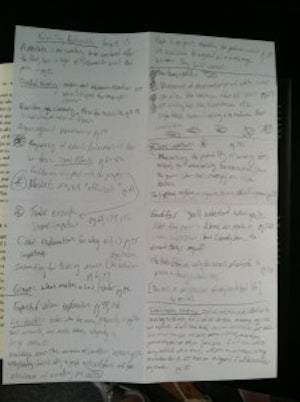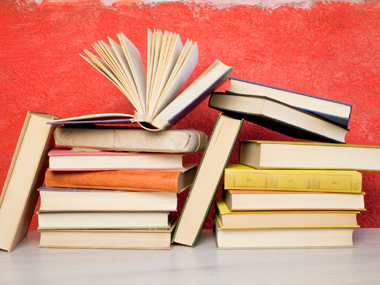A few months back, while trying to recall some information, I came to realise that I often only remember a hazy outline of the books I read. This really bothered me – as trivial as it may seem, I couldn’t accept that after investing countless hours reading, I could only remember an outline of a book and little detail.
I wanted to do something about it. There had to be a way to remember more – there just had to be.
Naturally, I dived in and started reading all I could about memory – soaking up information from books and articles, but I didn’t stop there, no – I started experiementing.
Below is the simple three step system I use for reading for maximum retention. I don’t claim to have crafted anything revolutionary, but what I have done is pull exsisting ideas together to solve a specific problem: How to read mulltiple books simulateneously and rememeber (almost) everything. Definitly something worth sharing.
Why read multiple books simultaneously?
As strage as it may sound, I don’t read one book at a time, and I can’t imagine doing so. As a curious lover of knowledge I find myself jumping around from book to book, wanting to learn everything about everything, so I sought out to optimise my approach to reading. You may not want to read ten books simulateneousl – that’s ok. This simple method can still help you remember more of what you read.
The three steps are:
1. Read one chapter at a time
2. Makes notes as you read
3. Review notes before and after reading
As you can see, this it’s really simple. You’re probably thinking too simple, but that’s what we need: simplicity. When I read, I want to focus on reading – I don’t want a system or method getting in the way.
Let’s take a look at why this system actually works.
Chunking
Information is best retained when broken into small ‘chunks’ a classic everyday example is in the way we read and recite telephone numbers.
0207 123 1231 vs 02071231231
Was it easier to remember the first string of numbers? I’m certain you’ll say yes. However, a better question is: why are a string of numbers broken into chunks easier to rememeber? Becaues the brain is able to focus more intensly when it has less to deal with. This isn’t rocket science – you probably could have told me this. However, is this piece of knowledge you apply? Information is useless without application.
The first step in my method is to read one chapter at a time. The idea is to constrain information so the brain is given a better oppourtunity to focus.
For a while, chunking seemed only useful for improving short term memory, that is until I read Moonwaling with Einstein. This book showed me how poweful chunking can be for long-term memory when combined with Mnemonics.
While I don’t feel Mnemonics is a practical solution for rememebering details from a book – It did have me wondering what else I could combine chunking with to maximise how much I remember from reading.
That’s when I re-discovered the forgetting curve. Aha!
The forgetting curve
The forgetting curve was first discovered by German psychologist Hermann Ebbinghaus. Through a series of experiments, he discovered when newly aquired information begins to deteriorate, and that by reviewing information at these points improves retention drastically. This was a great discovery.
The forgetting curve is what powers great programs like Anki and SuperMemo.

How is this helpful to us when reading? The second and third steps in this reading system involve the taking and reviewing of notes.
Reviewing all notes before reading each chapter will do two things: keep the information fresh in your brain and cement it further into your mind.
I often feel as though I’ve read a book many times by the time I read the last page.
In my case, reviewing notes takes a maximum of fifteen minutes, a small price to pay for an incredible increased rate of recall.
The quality of notes used for reviewing chapters will hugely impact the effectivness of this technique, be sure to subscribe to the RSS feed to make sure you don’t miss that article.
The system is really simple:
1. Read one chapter at a time
2. Makes notes as you read
3. Review notes before and after reading
Keeping Track of What You Want to Read
Nothing is worse than wanting to get a new book and facing the empty Amazon search bar, their shallow recommendations staring back at you, KNOWING that there’s something better out there for you, but not being able to remember the 10+ books that you really wanted to read but never wrote down.
I have a two pronged solution for this:
1. Evernote
2. Pinboard.in
I have one Evernote note (started in 2010) with almost every book that has caught my eye in the last three years. It’s pretty huge. Evernote is great for this purpose because it also has a mobile version, so wherever you are you can pull out your phone and type the book in for later.
I also use Pinboard.in which is a really simple bookmarking service to collect books. Typically these are ones that I find on Amazon that I want to save for later. Both of these options are good for maintaining your list–though if you have to choose one, Evernote is probably the best because it works on mobile.
The biggest problem with this is that it gets really unwieldy after a while. It’s hard to keep track of which books you’ve already read, and it’s hard to find the books that you have top of mind in a list that’s 100s of lines long.
Refining the List
To refine my list I use Trello. For example, when this summer began I took a bunch of the books from my Evernote list that I felt like I wanted to read and put them into a Trello Board called Books. On this board I categorize them into two lists: “To Read” and “Backlog.”

Above: My “Books” Trello board
“To Read” is composed of things that I want to read immediately. “Backlog” is composed of things that I want to read some time this summer. Whenever I’m in a bookstore or I get a book recommendation that I’m really excited about I put the book into my “To Read” list.
What I find often is that when I first hear about a book it will get me excited and I’ll want to read it immediately. But after a few days or weeks it will excite me less. If that happens I’ll move the book from “To Read” to “Backlog.” And after a while if it stays in “Backlog” I’ll move it back to my Evernote list.
The advantage of using Trello is a few-fold:
- It keeps everything much more organized than Evernote
- It allows you to keep track of what you want to read, what you’re reading, and what you’ve already read in a pleasing way
- By putting books that you’re excited about into the list and letting them sit there for a few days or weeks, it allows you to separate the books that you actually want to read from the books that lose their appeal quickly
Actually Doing the Reading
I have a rule for myself: I never read more than one book at a time, and I always finish every book I start.
I started doing this because I had a tendency to read five books at once. When you get into the habit of doing that, you end up never actually finishing anything. You’ll read a book for a few chapters, and then put it down for another one. This is annoying and doesn’t get you the satisfaction of reading a book from start to finish. By limiting myself to one book at a time and committing to finish it, I actually end up reading more books than if I read a bunch of them in parallel.
Retaining What You Read

I have a couple of techniques for this depending on the book. For every (important) physical book that I’ve read since I high school I do exactly the same thing: I take a blank sheet of paper and fold it four ways into a square. I put the title of the book at the top and the date. Then as I’m reading I take notes on important themes or messages on the piece of paper, and write the page number that it shows up in. If I see the theme pop up in another section of the book I’ll go back to the original note and add the new page number.
Pictured at left: my notes from the last book I read, Fooled By Randomness
By the time I’m finished with the book I have a list of all the things I found interesting / insightful about it, and a list of all the page numbers where those things were discussed. This makes it really easy to pick up a book a few years after you first read and it figure out exactly what I thought was important about it. It also makes it easier to write about the books because I can usually pull out good quotes really quickly.
The other thing I’ve started to do recently is to write up my notes in Evernote. Having a piece of paper stuck inside the physical book is great (and doubles as a nice bookmark) but if you’re somewhere other than your house, it’s frustrating to not be able to access the information wherever you want. Typing the notes into Evernote on the other hand gives you access any time, from anywhere.
The other good thing about writing things out (whether by hand or by computer) is that you tend to remember them better. I’ve always been bothered by not remembering the things I read, and this seems to be a nice way to get the most out of the time you spend reading.
